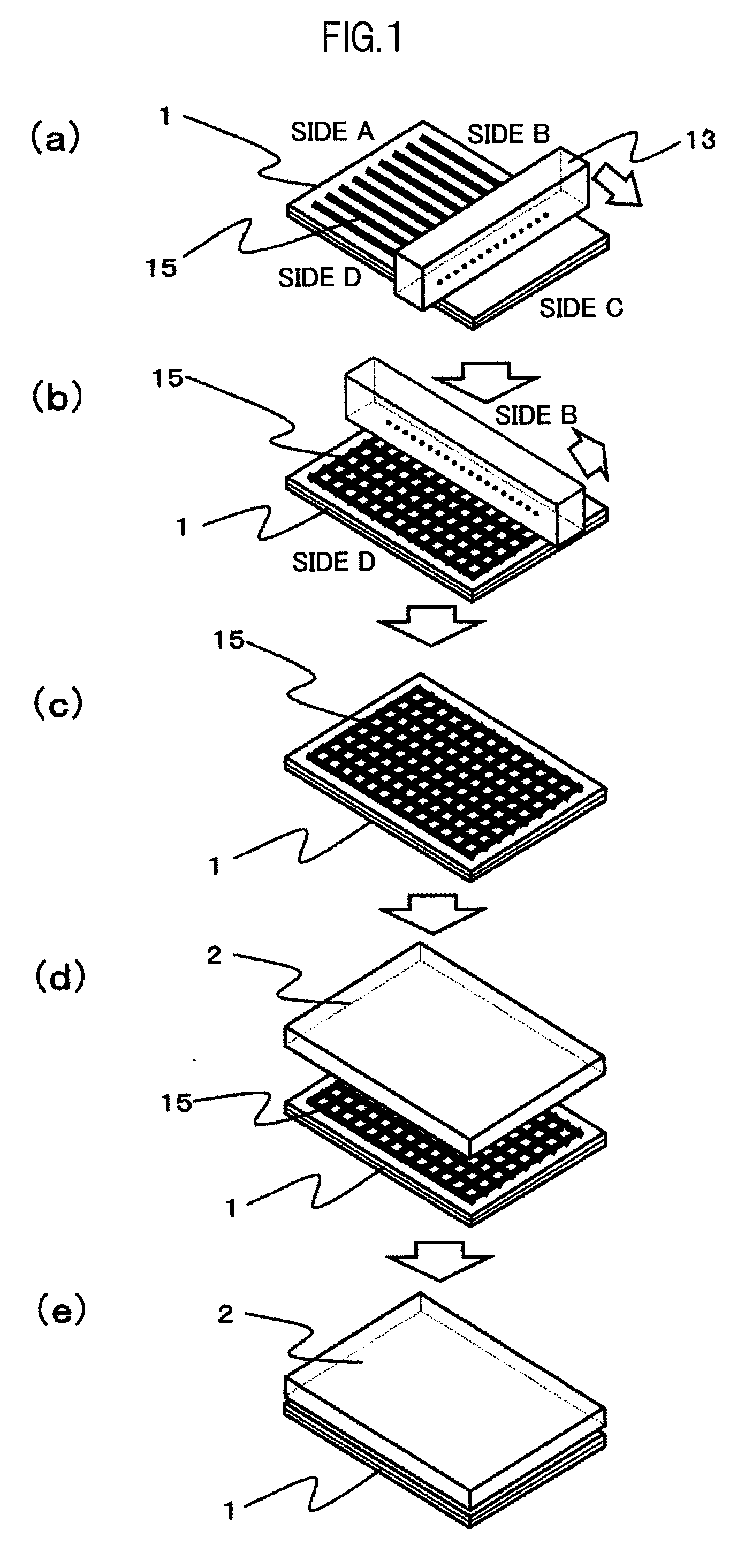Method of manufacturing a display
a display and manufacturing method technology, applied in the field of manufacturing a display, can solve the problems of affecting the visibility of a displayed image, affecting the effect of display quality, so as to keep the equipment cost necessary and short time without trapping air bubbles
- Summary
- Abstract
- Description
- Claims
- Application Information
AI Technical Summary
Benefits of technology
Problems solved by technology
Method used
Image
Examples
first embodiment
[0204]A first embodiment of the present invention is described with reference to FIGS. 1A to 1E. First, the multi-application nozzle 13 is used to apply the liquid organic medium 15 to a surface of the liquid crystal display panel 1 from Side A to Side C (or from Side C to Side A; either way, the direction does not matter) in a stripe pattern (FIG. 1A). Next, the liquid organic medium 15 is applied to the same surface of the liquid crystal display panel 1 from Side D to Side B (or from Side B to Side D; either way, the direction does not matter) in a stripe pattern that intersects the previously formed stripe application pattern (FIG. 1B). A grid pattern illustrated in FIG. 1C is thus formed. Although FIGS. 1A to 1C illustrate a method of using the multi-application nozzle 13 to form a grid-like application pattern, the grid-like application pattern may be formed by screen printing or offset printing as described in [Liquid Organic Medium Application Methods].
[0205]Next, the protect...
second embodiment
[0207]A second embodiment of the present invention is described with reference to FIGS. 6A to 6F. First, the multi-application nozzle 13 is used to apply the liquid organic medium 15 to a surface of the liquid crystal display panel 1 from Side A to Side C (or from Side C to Side A; either way, the direction does not matter) in a stripe pattern (FIGS. 6A and 6B). Next, the multi-application nozzle 13 is used to apply the liquid organic medium 15 to a surface of the protective plate 2 from Side D to Side B (or from Side B to Side D; either way, the direction does not matter) in a stripe pattern (FIGS. 6C and 6D). Although FIGS. 6A to 6D illustrate a method of using the multi-application nozzle 13 to form a stripe application pattern, the stripe application pattern may be formed by screen printing or offset printing as described in [Liquid Organic Medium Application Methods].
[0208]Next, the protective plate 2, where the liquid organic medium 15 has been formed in a stripe pattern, is p...
third embodiment
[0210]A third embodiment of the present invention is described with reference to FIG. 7. First, a slit application nozzle 14 is used to apply the liquid organic medium 15 solidly to a surface of the liquid crystal display panel 1 from Side D to Side B (or from Side B to Side D, from Side A to Side C, from Side C to Side A; any way, the direction does not matter) (FIGS. 7A and 7B).
[0211]Next, the multi-application nozzle 13 is used to apply the liquid organic medium 15 to a surface of the protective plate 2 from Side A to Side C (or from Side C to Side A; either way, the direction does not matter) in a stripe pattern (FIG. 7C). The liquid organic medium 15 is then applied to the same surf ace of the protective plate 2 from Side D to Side B (or from Side B to Side D; either way, the direction does not matter) in a stripe pattern that intersects the previously formed stripe application pattern (FIG. 7D). A grid pattern illustrated in FIG. 7E is thus formed.
[0212]Thereafter, the protect...
PUM
| Property | Measurement | Unit |
|---|---|---|
| refractive index | aaaaa | aaaaa |
| width | aaaaa | aaaaa |
| thickness | aaaaa | aaaaa |
Abstract
Description
Claims
Application Information
 Login to View More
Login to View More - R&D
- Intellectual Property
- Life Sciences
- Materials
- Tech Scout
- Unparalleled Data Quality
- Higher Quality Content
- 60% Fewer Hallucinations
Browse by: Latest US Patents, China's latest patents, Technical Efficacy Thesaurus, Application Domain, Technology Topic, Popular Technical Reports.
© 2025 PatSnap. All rights reserved.Legal|Privacy policy|Modern Slavery Act Transparency Statement|Sitemap|About US| Contact US: help@patsnap.com



